Screen I–III 2018/2016
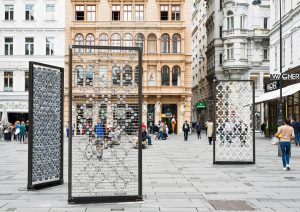
Installation view
“KÖR” Kunst im öffentlichen Raum, Graben, Wien
(photo credit: Andrea Pickl)
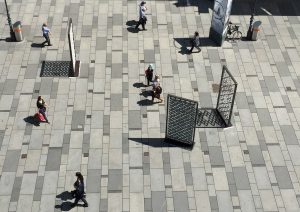
Installation view
“KÖR” Kunst im öffentlichen Raum, Graben, Wien
(photo credit: Iris Ranzinger)
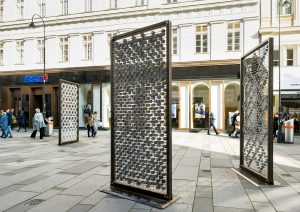
Installation view
“KÖR” Kunst im öffentlichen Raum, Graben, Wien
(photo credit: Andrea Pickl)
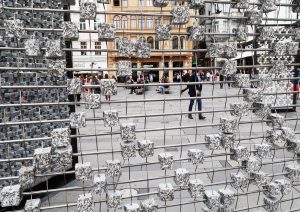
Installation view
“KÖR” Kunst im öffentlichen Raum, Graben, Wien
Screen III, 2016
(photo credit: Andrea Pickl)
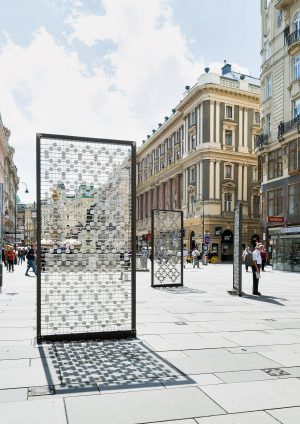
Installation view
“KÖR” Kunst im öffentlichen Raum, Graben, Wien
Screen I, 2016
(photo credit: Andrea Pickl)
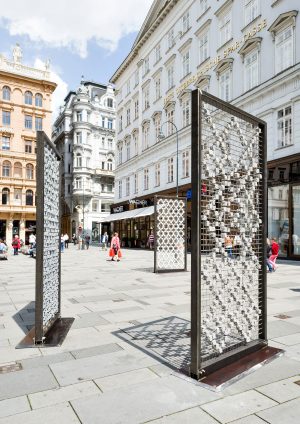
Installation view
“KÖR” Kunst im öffentlichen Raum, Graben, Wien
(photo credit: Andrea Pickl)
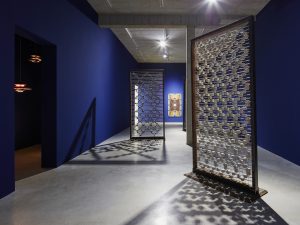
Installation view
Sammlung Philara, Düsseldorf
(photo credit: Paul Schöpfer)
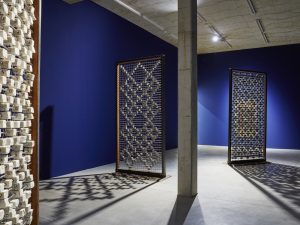
Installation view
Sammlung Philara, Düsseldorf
(photo credit: Paul Schöpfer)
“KÖR” Kunst im öffentlichen Raum, temporary intervention in public space, Graben, Vienna, 2016
Cobblestones, steel frames, stainless steel grid
H 310 × W 150 × D 15 cm
Screen I: Rauriser white marble cobblestones (320 pieces)
Screen II: Rauriser blue black cobblestones (589 pieces)
Screen III: Waldviertler spotted granite cobblestones (261 pieces)
Screen I–III, Nevin Aladağ’s intervention on Vienna’s Graben, temporarily lays claim to, and thus defines and defies a bustling urban place. Three screens obstruct and disguise the commotion of the inner city and, with their stony presence, adorn the promenade like tapestries. Marking the boundaries of a space, drawing contours and axes within a field of movement regulated by shop windows and urban furniture, and mapping a place of engagement, the screens evade the everyday protocols.
Screens are, for Aladağ, many things. They signify a camouflage, veil, protective wall, grid, but also a projection surface. They are hybrid elements, which not only block out and shield but also disclose and represent. These screens could also be read as descendants of the so-called Mashrabiyas, semitransparent ornamental walls that have been used in the Arab world for many centuries and have decisively contributed to the codification and geometrization of the gaze. Their most sophisticated forms attest to the systematic deconstruction and algorithmic generation of form and figure.
Cobblestones of Rauris marble and Waldviertel granite are inlaid and arranged in different ornamental configurations that keep both the pattern and the material in precarious suspense. Carefully selected to fit in with the pavement of Vienna’s city center, the stones quietly carry cultural-historical connotations, beckoning to their alternative uses as missiles, construction material for barricades, and proletarian weapons. Disentangling the architectonic elements of the screen and the stone block from their familiar functions, Aladağ releases hidden narratives and opens up spaces which stimulate action and engagements and turn into dispositives of story-telling.
(Daniela Zyman)







